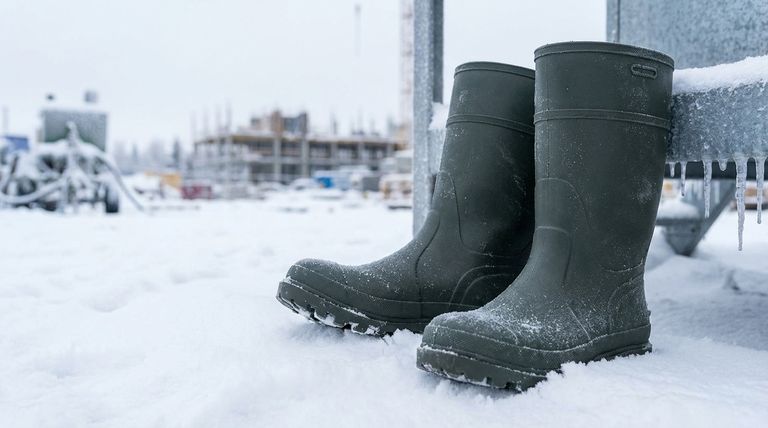Yes, but with critical caveats. A Wellington boot's suitability for snow depends entirely on its specific features. While their inherent waterproof design is excellent for wet slush, a standard, unlined boot will fail to provide the necessary warmth and traction for truly cold or icy conditions.
The core issue is that while all Wellington boots are waterproof, not all are designed for winter. True snow-suitability requires two additional, non-negotiable features: insulation for warmth and a high-traction outsole for safety.

The Primary Advantage: Unmatched Waterproofing
The Rubber Barrier
Wellington boots are typically made from a single piece of molded rubber or a similar waterproof synthetic. This construction creates an impermeable barrier against moisture.
This design makes them exceptionally effective at handling the wet, slushy snow common during thaws or in milder winter climates.
Keeping Feet Dry
The first defense against cold feet is keeping them dry. By preventing snow and slush from seeping in, Wellies excel at this fundamental requirement, which is a common failure point for boots made of leather or stitched textiles.
The Critical Weaknesses of Standard Wellies
The Cold Truth About Insulation
A basic Wellington boot is simply a waterproof shell. The rubber itself offers virtually no insulation.
Without a dedicated lining, your body heat will rapidly escape, leaving your feet cold, especially in freezing temperatures or when stationary for long periods.
The Traction Deficit
Many standard Wellies have a relatively flat and simple sole pattern designed for mud, not ice.
This lack of deep, specialized lugs provides poor grip on packed snow and can be dangerously slippery on icy surfaces, significantly increasing the risk of falls.
Evolving the Wellington for Winter Conditions
The Role of Insulation
Modern, winter-specific Wellington boots solve the warmth problem by incorporating insulation directly into the boot's design.
Look for materials like neoprene, a synthetic rubber that traps air for excellent thermal retention, or soft fleece linings. A 5mm neoprene lining, for example, is often rated for sub-freezing temperatures.
Designing for Aggressive Grip
Manufacturers address the safety issue with advanced outsole designs. These soles are made from softer rubber compounds that stay flexible in the cold.
They feature deep, multi-directional lugs and patterns specifically engineered to bite into snow and provide stable footing on slippery ground. Look for terms like slip-resistant or tri-density soles.
The Importance of Boot Height
Taller Wellington boots provide an obvious advantage in deeper snow. They prevent snow from coming over the top of the boot, ensuring your feet and lower legs stay completely dry and protected.
Making the Right Choice for Your Goal
To determine if a Wellington boot is right for you, consider your most common winter scenario.
- If your primary focus is clearing wet, slushy snow from the driveway: A standard Wellington with thick, thermal wool socks is likely sufficient for short-term use.
- If your primary focus is daily activity in consistently cold and snowy weather: You must choose a purpose-built winter Wellington with integrated neoprene or fleece insulation and a high-traction sole.
- If your primary focus is walking on frequently icy paths or trekking: A dedicated winter hiking boot with specialized ice-gripping technology may be a safer and more comfortable choice.
By prioritizing insulation and traction, you can effectively determine if a Wellington boot is truly equipped to handle your winter needs.
Summary Table:
| Feature | Standard Wellies | Winter-Specific Wellies |
|---|---|---|
| Waterproofing | Excellent | Excellent |
| Insulation | None (requires thick socks) | Built-in (e.g., neoprene, fleece) |
| Traction on Snow/Ice | Poor (flat soles) | Excellent (deep-lug, slip-resistant soles) |
| Best For | Wet slush, short-term use | Consistently cold & snowy conditions |
Need reliable, high-performance winter boots for your business?
As a large-scale manufacturer, 3515 produces a comprehensive range of insulated and high-traction Wellington boots for distributors, brand owners, and bulk clients. Our production capabilities ensure your customers get the warmth, safety, and durability they need for harsh conditions.
Contact our team today to discuss your winter footwear requirements and explore our catalog.
Visual Guide

Related Products
- Safety Footwear Wholesale Manufacturer for Custom OEM/ODM Production
- Factory-Direct Wholesale Canvas Boots with High-Traction Rubber Soles
- Wholesale Safety Footwear Manufacturer for Bulk & Custom OEM Orders
- High Performance Fire-Retardant Waterproof Safety Boots
- Premium Flame-Retardant Waterproof Safety Boots and Shoes
People Also Ask
- What are the cultural perspectives on wearing shoes in the house? A Guide to Home Etiquette & Hygiene
- How do safety shoes contribute to cost savings for companies? A Strategic Investment in Risk and Cost Management
- Is it normal to wear shoes in the house? A Guide to Hygiene, Comfort & Culture
- What cultural and environmental considerations are tied to wearing shoes indoors? Balance Hygiene, Tradition, and Foot Health
- What are OSHA approved shoes? Understanding the Correct Standards for Workplace Safety



















